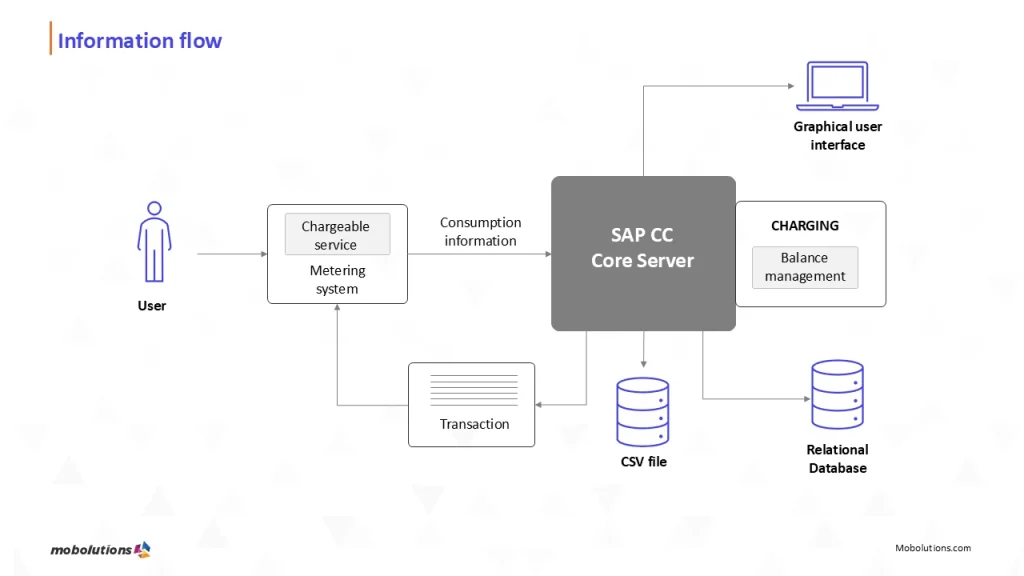In the rapidly changing digital economy of today, consumers want instant access to various services such as calling, watching movies, or accessing cloud software. Behind this convenience, though, is a tricky issue: how do businesses ensure that they charge consumers in real time in a fair and accurate manner for their usage?
Without real-time charging, businesses face:
- Delayed billing and frustrated customers
- Inaccurate usage tracking
- Missed revenue due to outdated or batch-only billing systems
That’s where SAP Convergent Charging (SAP CC) comes in.
Key Features of SAP CC:
- Real-Time Charging: In SAP CC refers to the process of calculating and applying charges immediately when a customer uses a service. It’s a live, dynamic process that ensures customers are charged the correct amount the moment they consume a product or service—without delay.
How It Works:
- Customer Uses a Service
For example: making a phone call, using mobile data, or purchasing a digital subscription. - Service Usage Event is Captured
The service platform detects the usage and sends the usage request (event) to SAP CC. - SAP CC Calculates the Charge
SAP CC uses the predefined charging logic and price plans to:- Rate the event (how much it costs)
- Check the customer’s balance (if prepaid)
- Approve or deny the service based on balance or quota
- Charge is Applied Instantly
The charge is applied right away, and feedback is sent back to the service platform (e.g., continue the call or stop it if the balance is low).
Key Features of Real-Time Charging:
Instant Rating and Charging is one of the most significant and dynamic aspects of SAP Convergent Charging (SAP CC). It allows service providers, especially those from industries like telcos, utilities, and digital services, to charge services in real time, simultaneously with their consumption by the customer. The following section demonstrates an extensive overview of its importance and working mechanism:
What is Instant Rating and Charging?
At its core, instant rating and charging refers to the ability of SAP CC to:
- Analyze usage data (e.g., a phone call, data session, streaming video)
- Apply complex pricing logic
- Calculate the cost of usage
- Deduct charges (for prepaid customers) or record them (for postpaid customers)
- All within milliseconds of the usage happening
This is not delayed billing or batch processing—it’s real-time charging.
How It Works — Step-by-Step
Here’s how SAP CC performs instant rating and charging under the hood:
- Usage Event Detected
A user performs an action (e.g., starts a call, sends data, accesses a premium service).
- Mediation & Data Collection
The SAP Convergent Mediation system or another network system collects the raw event (e.g., a 10-minute phone call).
- Request Sent to SAP CC
A charging request is immediately sent to SAP CC Core Server, typically over Diameter protocol, HTTP(S), or SOAP, depending on the integration setup.
- Decision Tree & Charge Plan Evaluation
SAP CC uses the predefined pricing logic set in:
- Charge Plans
- Decision Trees
- Refill Plans (for prepaid)
It evaluates:
- Time of day
- Duration
- Type of service
- Tiered rates
- Free minutes/data
- Any discounts or promotions
- Real-Time Response
- For prepaid, SAP CC checks if the customer has sufficient balance. If yes, it deducts the charge and sends a “charge accepted” signal.
- For postpaid, it records the charge and sends confirmation to proceed.
The decision happens in milliseconds, which allows services to continue without any noticeable delay.
- Dynamic pricing support (e.g., time-based rates, promotional discounts).
- Usage control (e.g., stop service if quota is exhausted).
- Prepaid and Postpaid Support:
- Prepaid: Deducts balance instantly.
- Postpaid: Accumulates charges for billing later
Benefits:
- Improved Customer Experience: Customers know their remaining balance or usage instantly.
- Revenue Assurance: No service is delivered without checking if the customer can pay.
- Flexibility: Allows for real-time promotions or adjustments in pricing.
Example Scenario:
A customer starts streaming a movie on a telecom network.
→ SAP CC checks if the user has enough data balance.
→ If yes, streaming begins and data usage is charged in real-time.
→ If the balance is exhausted, the session is stopped or paused.
Flexible Pricing Models in SAP CC
One of the most powerful features of SAP Convergent Charging (CC) is its dynamic and adaptive pricing scheme support. This feature allows service providers—telecommunications and utility firms, for example—to tailor charging rules based on customer usage patterns, service timing, and specific consumption patterns. It also allows for the delivery of more tailored, usage-priced offers that address customer needs and expectations.
What Does “Flexible Pricing” Mean?
It means SAP CC lets you define and apply different charging strategies, depending on the product, customer type, usage behavior, or even time of day.
Main Pricing Models in SAP CC:
- Subscription-Based Pricing
- What it is: Customers pay a fixed recurring fee, usually monthly or yearly.
- Use Case: Streaming services, data plans, SaaS products.
- Example: $10/month for unlimited music streaming.
- Usage-Based Pricing
- What it is: Charges are based on how much of the service the customer uses.
- Use Case: Telecom (per minute or MB.
- Example: $0.05 per MB of mobile data used.
- Hybrid Pricing (Prepaid/Postpaid)
- What it is: A combination of subscription and usage-based pricing, or offering both prepaid and postpaid options.
- Use Case: Telecoms or internet services where users pay a monthly fee, but extra usage is billed separately.
- Example: $20/month for 10GB data + $0.02/MB after limit.
- Time-Based or Event-Based Pricing
- What it is: Charges vary depending on the time or event.
- Use Case: Discounts during off-peak hours or surge pricing during events.
- Example: $0.10/min for calls during the day, $0.05/min at night.
- Tiered or Volume-Based Pricing
- What it is: Pricing changes based on how much is consumed (volume tiers).
- Use Case: Encouraging more usage with discounts.
- Example: First 100 units at $0.10, next 100 at $0.08, etc.
Why Is This Important?
- Enables business innovation: You can launch creative offers and promotions quickly.
- Supports customer personalization: Different pricing for different customer groups.
- Improves revenue optimization: Charge based on value delivered.
High Performance:
What sets SAP Convergent Charging (SAP CC) apart is that it can handle large volumes of transactions in real-time, both in terms of timing and accuracy. It has been tuned up for markets like the telecommunication, media, and utilities industries where charging events like data consumption, voice calls, or content streaming happen repeatedly.
Batch Processing:
Allows for offline charging of large volumes of transactions, providing flexibility for various business needs.
Batching in SAP Convergent Charging (SAP CC) is a method of processing a volume of charging requests that are not under real-time immediate responses. As opposed to online or real-time charging, where the system charges and rates transactions in real time as they happen, batching allows the gathering of usage over a time period and processing it in batches at a scheduled interval.
- Integration with SAP BRIM:
Seamlessly integrates with other BRIM components, enabling a comprehensive billing and revenue management solution.
- Online and Offline Agents:
Uses Online and Batch agents to interact with SAP CC and process charging requests.
In essence, SAP CC is the core engine that drives the real-time and batch charging functionality within SAP BRIM, enabling businesses to effectively manage their billing and revenue streams.
Ready to simplify complex charging scenarios and boost revenue accuracy? Partner with Mobolutions to unlock the full potential of SAP Convergent Charging. Let’s build smarter, customer-centric pricing models—tailored for your industry. Contact us at info@mobolutions.com today to get started.






